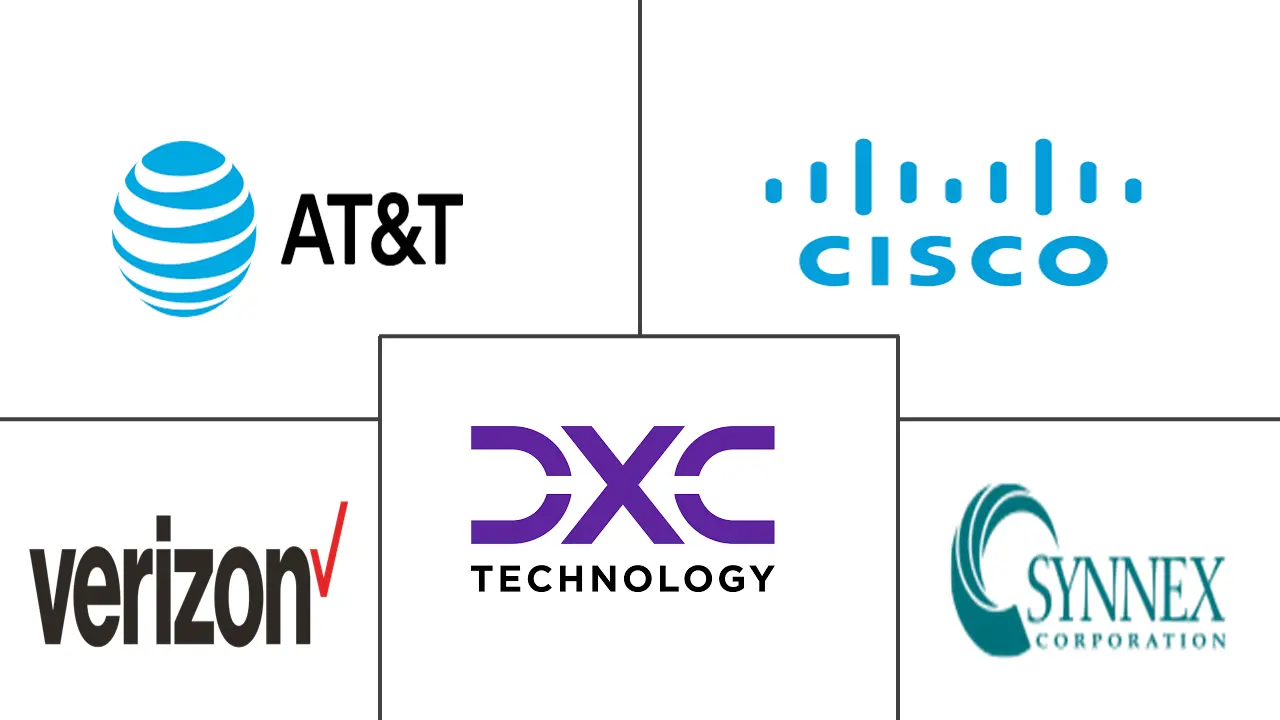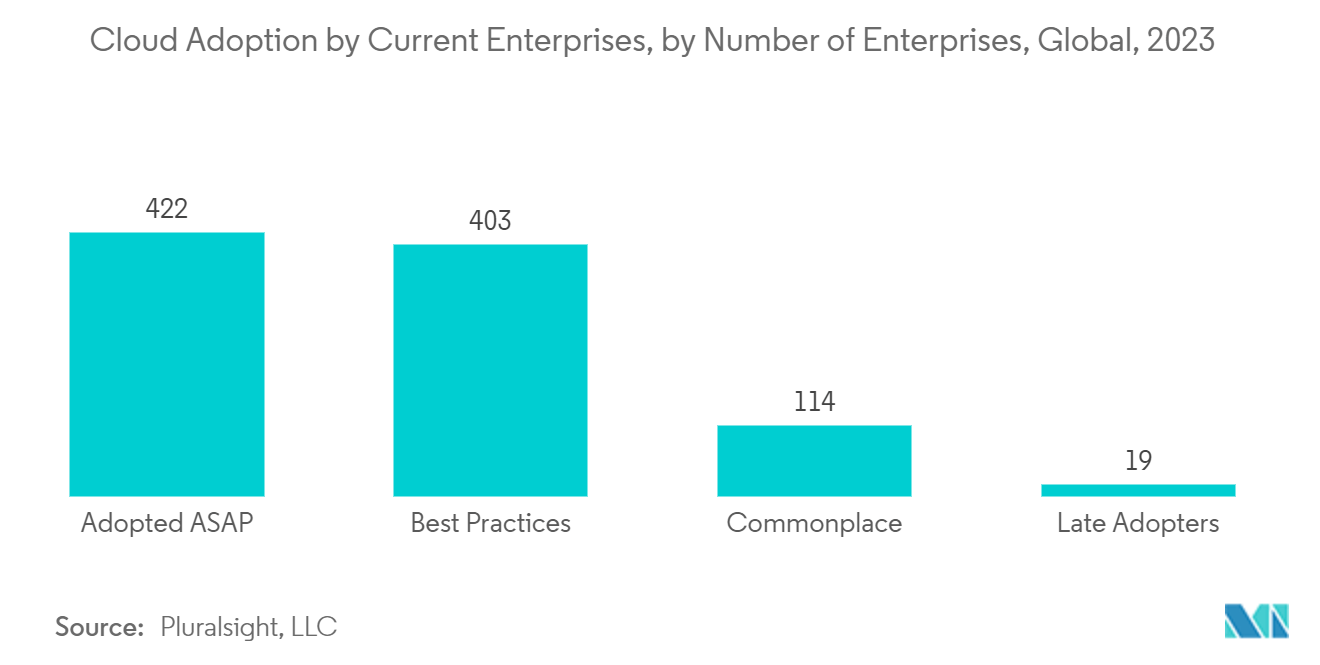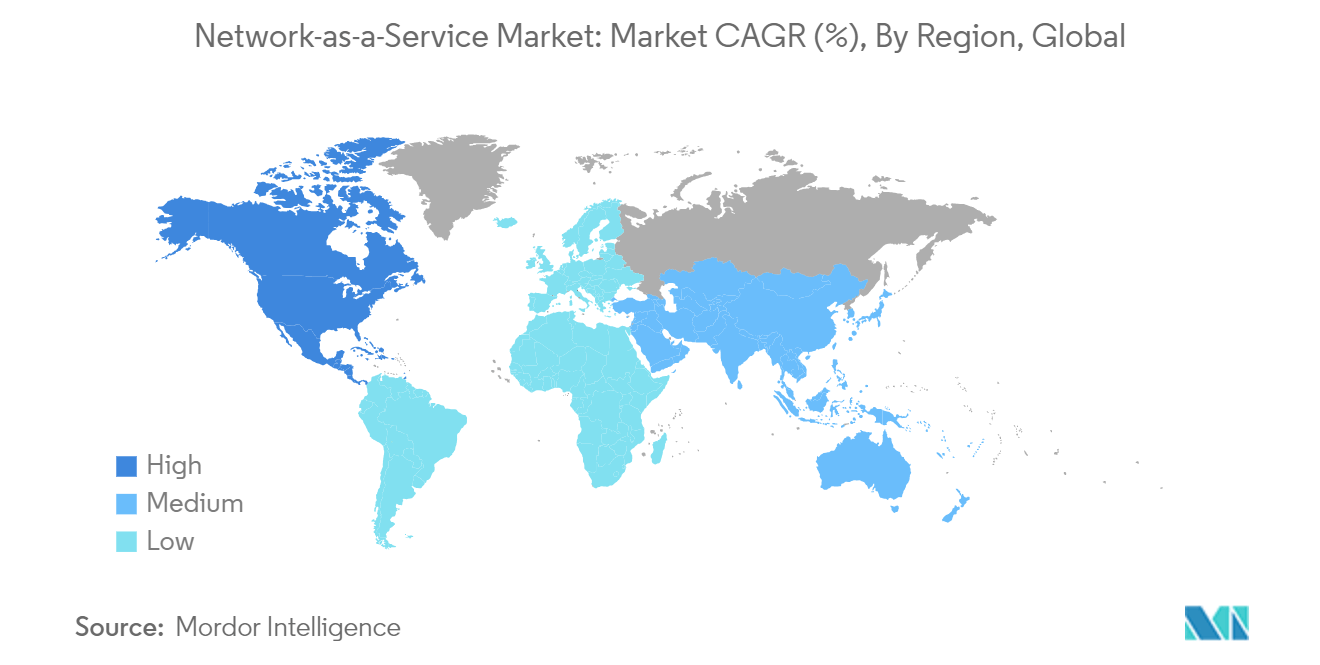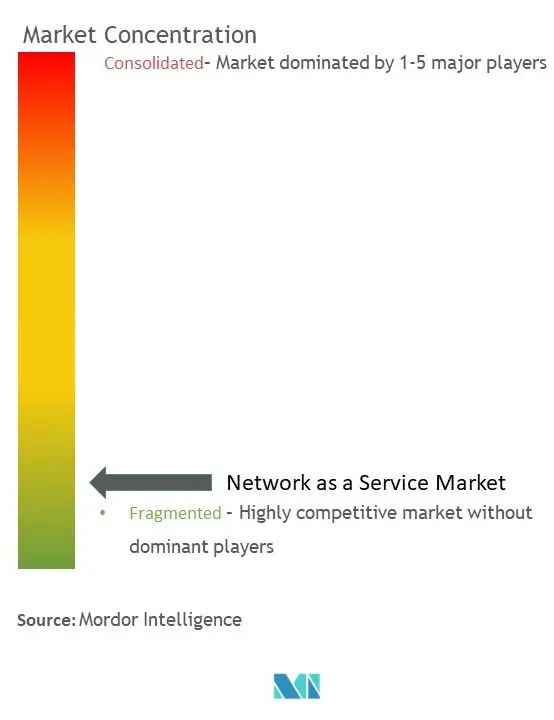Network as a Service Market Size

| Study Period | 2019 - 2029 |
| Market Size (2024) | USD 25.67 Billion |
| Market Size (2029) | USD 103.19 Billion |
| CAGR (2024 - 2029) | 32.09 % |
| Fastest Growing Market | Asia-Pacific |
| Largest Market | North America |
Major Players
*Disclaimer: Major Players sorted in no particular order |
Network as a Service Market Analysis
The Network As A Service Market size is estimated at USD 25.67 billion in 2024, and is expected to reach USD 103.19 billion by 2029, growing at a CAGR of 32.09% during the forecast period (2024-2029).
Network-as-a-Service (NaaS) offers organizations and companies greater flexibility and even performance gains in their network infrastructure. With on-demand purchasing, firms can be more cost-conscious and pay only for the necessary networking services. Network-as-a-Service (NaaS) can also enable organizations that need greater flexibility in provisioning without having to rearchitect networks or redo contracts from the ground up.
- The broad construction of new data center infrastructures worldwide drives the growth of the Network-as-a-Service (NaaS) market. Several main drivers drive this expansion, including the increasing use of cloud computing for data storage, the incorporation of big data analytics, and virtualization within that center to improve workload mobility. These advancements have resulted in better resource utilization, higher availability, lower total costs, and increased reliability and security for critical corporate applications.
- Furthermore, the increasing need for subscription-based and pay-per-use business models in network virtualization, cloud computing, and software-defined networking (SDN) is significantly impacting the market trajectory. The growing use of cloud services, which cater to the demands of large and small organizations, plays a significant role in shaping the industry landscape.
- NaaS gives businesses more flexibility and the opportunity for improved network performance. Organizations can emphasize cost-effectiveness by paying for the precise networking services requested via on-demand purchases. NaaS also enables businesses that need more provisioning flexibility without redoing their network or contract.
- Network-as-a-Service (NaaS) offers significant advantages; it is important to acknowledge certain obstacles and potential reliability issues that could hinder its growth in the foreseeable future. Opting for a third-party network infrastructure provider to host critical corporate infrastructure requires faith in the supplier's long-term stability. Businesses may face the challenge of replacing essential infrastructure if the provider fails to remain competitive.
- Since the outbreak of the COVID-19 pandemic, the demand for cloud-based solutions has seen significant growth owing to remote working models being adopted by enterprises; however, various industries such as retail, manufacturing, and BFSI have seen a considerable revenue slump. With the growing remote working model, companies are increasing investments in cloud-based analytics and assurance, edge computing, and AI-powered networking technologies, which are expected to boost the NaaS market.
- According to a survey by Aruba of 2,400 IT decision-makers, in response to the pandemic, 38% of IT leaders plan to increase their investment in cloud-based networking and 35% in AI-based networking as they seek more agile, automated infrastructures for hybrid work environments. Network-as-a-Service’s adoption is expected to accelerate by 38% within the next two years as businesses adapt to the post-pandemic environment.
Network as a Service Market Trends
Increased Adoption of Cloud Services among Enterprises to Drive the Market
- The growing use of technology and customer preference for remote data access drives the increased need for cloud-based solutions. Companies understand the cost and resource savings benefits of migrating to the cloud rather than maintaining on-premise infrastructure, leading to increased adoption among large corporations and SMEs. Cloud computing and virtualization are expected to lower software setup costs and hardware utilization during the next five years.
- According to Thales Group, more than 60% of corporate data was kept in the cloud last year, a massive increase from 30%. These trends create considerable potential prospects for manufacturers in this market, with the increasing adoption of cloud computing among organizations broadening the market's scope.
- For instance, according to Druva Inc., a company located in India, numerous companies focus on enterprise data mainly because of its substantial volume of unstructured data. According to the company, this data type is held in enterprise storage systems. Furthermore, according to the most recent Cisco Global Index, cloud data centers currently manage 94% of all computing workloads, while traditional data centers handle only 6%. This figure emphasizes the global potential for cloud-based contact center deployment in the future.
- Banking and other vital businesses are expected to embrace cloud-based service rollout rapidly. This is due to the IT industry's continued quest for simplified infrastructure and solution developers' ability to create hybrid cloud solutions by obtaining application and infrastructure components from different providers. This tendency is driving the Network-as-a-Service (NaaS) market forward.
- According to Pluralsight LLC, in 2023, 94% of organizations used cloud services for their technology initiatives. In a company survey of over 1,000 leaders and technologists across industries worldwide to find out how organizations leverage cloud computing, 70% of organizations report that more than half of their infrastructure exists in the cloud. Around 49% are actively moving more of their data to the cloud. Such data indicates a rapid adoption of new cloud services.

North America to Occupy Significant Market Share
- The United States has developed an economy that embraces advanced technology, propelling the expansion of network automation, cloud-based services, and the Network as-a-Service (NaaS) market. IT teams are set to adopt NaaS solutions from suppliers that offer hybrid solutions, including software, cloud intelligence, and the autonomy to manage on-premise hardware in the next five years.
- As a pioneer in technology adoption, the United States is experiencing a rise in demand for enhanced network services, driven by significant growth in mobile devices. With the growth of virtualized settings such as cloud software-defined networks (SDN) and virtual network functions (VNF), various network service providers (NSPs) in the region have enabled on-demand infrastructure. However, planning and acquiring network connectivity for organizations may take time and effort, posting difficulties for businesses attempting to stay up with digital trends and function at software-driven speeds.
- The Canadian NaaS market is expanding due to new product releases, acquisitions, mergers, partnerships, and collaborations transforming the North American market. There has been a noteworthy increase in cyberattacks on IT service providers, resulting in data breaches. As a result, the Canadian Center for Cybersecurity has issued recommendations to organizations, allowing them to be more selective when picking network service providers.
- Market demand is increasing significantly as automation and linked device deployment expand. The NaaS model is especially beneficial for small firms since it allows them to delegate day-to-day equipment upkeep and focus on their key capabilities, such as customer service. Given the prevalence of small enterprises in Canada, using NaaS is projected to grow considerably in popularity soon.

Network as a Service Industry Overview
The Network-as-a-Service market is fragmented due to the presence of several small and large players. The key players holding a prominent market share focus on expanding their customer base across regional boundaries. These companies leverage strategic collaborative initiatives to increase their market profitability and share. Some major players in the market are AT&T Intellectual Property, Verizon, and Cisco System Inc.
- February 2024: Nokia partnered with Liberty Global, a converged video, broadband, and communications company, in which Liberty Global's Belgian subsidiary Telenet utilizes Nokia's Network-as-a-Code platform to enhance the services offered at the Port of Antwerp. Developers can use application programming interfaces (APIs) and software development kits (SDKs) accessed via Nokia's Network as Code Platform with a developer portal to obtain network functionality and data. This will enable them to build new applications for use cases.
- October 2023: Lumen Technologies announced the integration of its Network-as-a-Service (NaaS) platform with Equinix Fabric, which will enable customers to instantly buy, use, and manage Lumen Internet On-Demand and future Lumen NaaS services. The company collaborates with Equinix to offer businesses a quick and easy network buying experience, providing customers access to quick bandwidth boosts and personalized on-demand services.
Network as a Service Market Leaders
-
DXC Technology Company
-
Cisco Systems Inc.
-
AT&T Intellectual Property
-
Verizon
-
TD SYNNEX Corporation
*Disclaimer: Major Players sorted in no particular order

Network as a Service Market News
- June 2024: Verizon Business announced that its NaaS cloud management service allows businesses to control application components and network architecture across cloud environments, all on one unified online portal. The solution works with Verizon Business' NaaS offering and simplifies multi-cloud management. Its comprehensive view of cloud network and application performance provides easy insight into service health, global network cloud connections, network traffic, and issue management tickets.
- March 2023: Akamai Technologies announced an agreement to acquire Ondat, a cloud-based storage technology provider with a Kubernetes-native platform for running stateful applications anywhere at scale. Acquiring Ondat's cloud storage technology and industry-recognized talent will strengthen Akamai's cloud computing offerings.
Network as a Service Market Report - Table of Contents
1. INTRODUCTION
- 1.1 Study Assumption and Market Definition
- 1.2 Scope of the Study
2. RESEARCH METHODOLOGY
3. EXECUTIVE SUMMARY
4. MARKET INSIGHTS
- 4.1 Market Overview
-
4.2 Industry Attractiveness - Porter's Five Forces Analysis
- 4.2.1 Bargaining Power of Suppliers
- 4.2.2 Bargaining Power of Buyers
- 4.2.3 Threat of New Entrants
- 4.2.4 Threat of Substitute Products
- 4.2.5 Intensity of Competitive Rivalry
- 4.3 Assessment of the Impact of COVID-19 on the Market
5. MARKET DYNAMICS
-
5.1 Market Drivers
- 5.1.1 Increased Adoption of Cloud Services among Enterprises
- 5.1.2 Augmentation in Software-defined Networking (SDN) Integration with Existing Network Infrastructure
-
5.2 Market Restraints
- 5.2.1 Privacy and Data Security Concerns
6. MARKET SEGMENTATION
-
6.1 By Type
- 6.1.1 LAN-as-a-Service
- 6.1.2 WAN-as-a-Service
-
6.2 By Application
- 6.2.1 Cloud-based Services (vCPE)
- 6.2.2 Bandwidth on Demand (BoD)
- 6.2.3 Integrated Network Security-as-a-Service
- 6.2.4 Wide Area Network (WAN)
- 6.2.5 Virtual Private Network (VPN)
-
6.3 By Industry Vertical
- 6.3.1 Healthcare
- 6.3.2 BFSI
- 6.3.3 Retail and E-commerce
- 6.3.4 IT and Telecom
- 6.3.5 Manufacturing
- 6.3.6 Transportation and Logistics
- 6.3.7 Public Sector
-
6.4 By Geography
- 6.4.1 North America
- 6.4.1.1 United States
- 6.4.1.2 Canada
- 6.4.2 Europe
- 6.4.2.1 United Kingdom
- 6.4.2.2 Germany
- 6.4.2.3 France
- 6.4.2.4 Rest of Europe
- 6.4.3 Asia-Pacific
- 6.4.3.1 China
- 6.4.3.2 Japan
- 6.4.3.3 India
- 6.4.3.4 Rest of Asia-Pacific
- 6.4.4 Latin America
- 6.4.4.1 Brazil
- 6.4.4.2 Argentina
- 6.4.4.3 Mexico
- 6.4.4.4 Rest of Latin America
- 6.4.5 Middle East and Africa
- 6.4.5.1 United Arab Emirates
- 6.4.5.2 Saudi Arabia
- 6.4.5.3 Rest of Middle East and Africa
7. COMPETITIVE LANDSCAPE
-
7.1 Company Profiles
- 7.1.1 AT&T Intellectual Property
- 7.1.2 Verizon
- 7.1.3 DXC Technology Company
- 7.1.4 TD SYNNEX Corporation
- 7.1.5 Cisco Systems Inc.
- 7.1.6 NEC Corporation
- 7.1.7 Hewlett Packard Enterprise Development LP
- 7.1.8 IBM
- 7.1.9 Oracle
- 7.1.10 GTT Communications Inc.
- 7.1.11 VMware Inc.
- 7.1.12 Telstra Group Limited
- 7.1.13 CenturyLink
- 7.1.14 Meta Networks Ltd (Proofpoint)
- 7.1.15 Masergy Communications Inc.
- 7.1.16 Juniper Networks Inc.
- 7.1.17 Nokia (Alcatel Lucent)
- 7.1.18 Akamai Technologies
- 7.1.19 Broadcom
- *List Not Exhaustive
8. INVESTMENT ANALYSIS
9. MARKET OPPORTUNITIES & FUTURE TRENDS
** Subject To AvailablityNetwork as a Service Industry Segmentation
Network-as-a-Service (NaaS) is the sale of network services by third parties to clients who do not want to construct their own networking infrastructure. NaaS solutions package networking resources, services, and applications as products that several customers or users can buy, usually for a contracted and defined period.
The Network-as-a-Service market is segmented by type (LAN-as-a-service and WAN-as-a-service), application (cloud-based services [vCPE], bandwidth on-demand [BoD], integrated network security-as-a-service, wide area network [WAN], and virtual private network [VPN]), industry vertical (healthcare, BFSI, retail and e-commerce, IT and telecom, manufacturing, transportation and logistics, and public sector), and geography (North America, Europe, Asia-Pacific, Latin America, and Middle East and Africa). The market sizes and forecasts are provided in terms of value (USD) for all the above segments.
| By Type | LAN-as-a-Service | |
| WAN-as-a-Service | ||
| By Application | Cloud-based Services (vCPE) | |
| Bandwidth on Demand (BoD) | ||
| Integrated Network Security-as-a-Service | ||
| Wide Area Network (WAN) | ||
| Virtual Private Network (VPN) | ||
| By Industry Vertical | Healthcare | |
| BFSI | ||
| Retail and E-commerce | ||
| IT and Telecom | ||
| Manufacturing | ||
| Transportation and Logistics | ||
| Public Sector | ||
| By Geography | North America | United States |
| Canada | ||
| By Geography | Europe | United Kingdom |
| Germany | ||
| France | ||
| Rest of Europe | ||
| By Geography | Asia-Pacific | China |
| Japan | ||
| India | ||
| Rest of Asia-Pacific | ||
| By Geography | Latin America | Brazil |
| Argentina | ||
| Mexico | ||
| Rest of Latin America | ||
| By Geography | Middle East and Africa | United Arab Emirates |
| Saudi Arabia | ||
| Rest of Middle East and Africa |
Network as a Service Market Research FAQs
How big is the Network As A Service Market?
The Network As A Service Market size is expected to reach USD 25.67 billion in 2024 and grow at a CAGR of 32.09% to reach USD 103.19 billion by 2029.
What is the current Network As A Service Market size?
In 2024, the Network As A Service Market size is expected to reach USD 25.67 billion.
Who are the key players in Network As A Service Market?
DXC Technology Company, Cisco Systems Inc., AT&T Intellectual Property, Verizon and TD SYNNEX Corporation are the major companies operating in the Network As A Service Market.
Which is the fastest growing region in Network As A Service Market?
Asia-Pacific is estimated to grow at the highest CAGR over the forecast period (2024-2029).
Which region has the biggest share in Network As A Service Market?
In 2024, the North America accounts for the largest market share in Network As A Service Market.
What years does this Network As A Service Market cover, and what was the market size in 2023?
In 2023, the Network As A Service Market size was estimated at USD 17.43 billion. The report covers the Network As A Service Market historical market size for years: 2019, 2020, 2021, 2022 and 2023. The report also forecasts the Network As A Service Market size for years: 2024, 2025, 2026, 2027, 2028 and 2029.
What are the latest trends in the Network as a Service (NaaS) Market?
Current trends in the Network as a Service (NaaS) Market are a) Integration of AI and machine learning for smarter network solutions b) Increased adoption of SD-WAN c) Expansion of 5G networks.
Network as a Service Industry Report
The network as a service (NaaS) market size is experiencing robust expansion, driven by the adoption of advanced technologies and a shift towards cloud computing. This growth is further fueled by the reduction in time and money spent on automation procedures, allowing organizations to align their expenses with actual consumption and scale operations flexibly. Despite challenges such as the lack of standardization, which affects regulatory compliance and technology security, the market sees opportunities in hybrid working models that enhance both employee healthcare and employer efficiency.
North America dominates the market share due to rapid adoption and the presence of key players. The market is segmented by organization size, with small and medium enterprises expected to grow at the highest rate, benefiting from the cost-efficiency and security enhancements provided by NaaS. For detailed statistics, market share, size, revenue growth rate, and a forecast outlook, access a free report PDF download from Mordor Intelligence™ Industry Reports on the Network as a Service market analysis.
The market trends indicate a significant shift towards cloud-based services, with virtual private networks and integrated network security-as-a-service being key applications. The industry analysis shows that sectors like healthcare, BFSI, retail and e-commerce, IT, and telecom are major contributors to the NaaS market growth. The market report highlights that the industry is poised for continued expansion, driven by market data and industry research.
In terms of geography, the global market is segmented into North America, Europe, Asia-Pacific, Latin America, and the Middle East and Africa. The market forecast suggests that Asia-Pacific will witness substantial growth due to increasing investments in technology and infrastructure. The industry outlook remains positive, with market leaders continuing to innovate and expand their offerings.
The industry reports and market overview further emphasize the importance of market segmentation and market value in understanding the dynamics of the NaaS market. The industry statistics and market predictions provide valuable insights into future trends and potential growth areas. The report example and report PDF offer a comprehensive view of the market, making it an essential resource for research companies and industry stakeholders.
Overall, the market review underscores the importance of staying updated with the latest industry information and market outlook to make informed decisions. The industry trends and market growth are clear indicators of the potential that the NaaS market holds, making it a critical area for investment and strategic planning.



